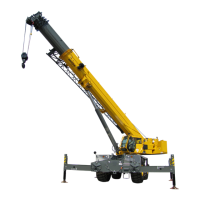National Crane 01-22-2019 Control # 051-08 2-11
1300A HYDRAULIC SYSTEM
PRESSURE SETTING PROCEDURES
Description
The hydraulic valves in the hydraulic system must be
properly adjusted to protect a component, circuit, or system
from over pressurization (relief valves) and ensure the
components receive the appropriate pressure and flow.
Maintenance
Relief valves are checked and adjusted by causing a given
circuit to reach its prescribed pressure limit (stall). At this
point the relief valve opens, returning hydraulic oil to the
reservoir. Hydraulic motor circuits can be stalled by
preventing rotation of the motor shaft prior to actuating the
control valve. Cylinder circuits can be stalled by extending or
retracting a cylinder to its limit of travel.
A pressure gauge placed in the proper line or test port shows
the pressure that the relief valve opens.
Correct relief valve adjustment is mandatory for proper
functioning of a hydraulic circuit. Only qualified technicians
using the correct equipment should make pressure
adjustments when pressure adjustments are needed.
The directional control valve has two main relief limiting
maximum operating pressure of the hoist, lift, and telescope
circuits. The swing circuit relief valve is located on the front
outrigger valve bank. There are also port relief valves in
some circuits which limit operating pressures as required by
circuit design. The pilot signal for shifting the HRC controls is
generated by a relief located in the crane manifold. The
crane manifold also provides the pressure to unlock the
swing brake.
NOTE: Use an accurate 0 to 5000 psi (0 to 34,500 kPa)
pressure gauge when adjusting relief valves. To
adjust a relief valve, turn the adjustment screw (in
to increase or out to decrease) until the proper
setting is reached.
Release the control lever after taking each reading
and while making adjustments. When the proper
pressure setting has been attained, tighten the
adjustment screw locknut and recheck the
pressure.
It is only necessary to hold hydraulic pressure long
enough (usually a few seconds) in the circuit to
gain an accurate reading. Do not overload the
hydraulic circuits for long periods of time.
Reservoir oil temperature is to be 140° - 160°F.
Preparation
• Start and warm up the engine until the hydraulic oil
temperature reaches a minimum of 60°-71°C (140°-
160° F).
• Shut down the engine.
CAUTION
Do not overtighten the adjustment screw or locknut.
Do not hold the relief valve open for more than one minute
at a time.
DANGER
Do not attempt to loosen the fittings in pressurized lines or
while the hydraulic pumps are in operation or personnel
injury could result.
Valve To Be Set
Pressure Setting
PSI (MPa)
Tolerance PSI
(kPa)
Adjustment Location
Telescope In Relief 2950 (20.33) +100/-0 (+689/-0) Directional Control Valve
Telescope Out Relief 2800 (19.30) +100/-0 (+689/-0) Directional Control Valve
Hydraulic Remote Controller Pilot 500 (3.44) +100/-0 (+689/-0) Crane Manifold
Swing/Outrigger Relief 3000 (20.68) +100/-0 (+689/-0) Front Outrigger Manifold
Lift and Pump Section P2 Relief 3600 (24.82) +100/-0 (+689/-0) Directional Control Valve
Hoist and Pump Section P1 Relief 3300 (22.75) +100/-0 (+689/-0) Directional Control Valve
Single Front Outrigger Extend 500 (3.44) +100/-0 (+689/-0) Port Block on Single Front Outrigger
Single Front Outrigger Retract 1750 (12.06) +100/-0 (+689/-0) Port Block on Single Front Outrigger

